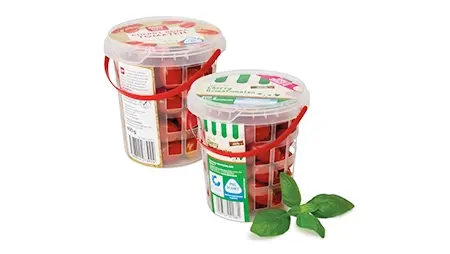Secure and attractively packed, significantly less material.
Bucket with grid structure ensures more careful use of resources:
Together with our long-standing customer LIMERA, we have brought this article into series production.
How can more resource-efficient packaging be produced that meets all customer requirements in terms of product protection, automation, logistics and marketing suitability? We took on this task together with our long-standing customer LIMERA and their customer Gartenbau Draek (tomato producer).
Our common goal was to develop a packaging for snack tomatoes that optimally fulfils all functionalities and at the same time convinces with regard to a more sustainable use of resources.
The plastic bucket has proven to be the most common form of packaging for snack tomatoes, protecting them from pressure, presenting them attractively and at the same time fulfilling all logistical requirements.
This gave rise to the idea of developing a bucket with a grid structure that has sufficient stability and requires less material to produce than these established round buckets.
The jury rating of the "Höfliche Verpackung" award is as follows:
Our colleague describes the special features of this resource-saving snack tomato packaging:
As a result, the bucket is equally convincing in terms of function and appearance:
- Transparent bucket with coloured handle (rim-full volume 870 ml).
- Decoration of the bucket by means of In-Mould-Labelling (IML).
- This high-quality look is resistant to moisture and temperature - a great advantage in the climatic conditions prevailing in cold stores and during transport.
- Lid made of fresh-fibre cardboard, can be printed over the entire surface.
- High recyclability, as mono-material solution: bucket made of polypropylene, lid cardboard.
The highlight: the bucket is not made entirely of plastic. The grid structure results in significant material savings - bucket with handle weighs only 21 grams. It is nevertheless very stable, protects its contents from damage and is machine-compatible.
The material savings compared to established round buckets mean savings in greenhouse gas emissions during transport - DSD fees are also lower.
Sustainable vegetable packaging:
Competences were bundled for this project.
An interdisciplinary team with industry-specific expertise worked on a resource-saving solution - without losing sight of product protection.
without losing sight of product protection:
- Pöppelmann FAMAC® contributed experience in the production of plastic food packaging.
- As a specialist in horticulture, Limera was very familiar with the requirements of the industry and also received detailed advice for the project from its customer, the tomato producer GARTENBAU DRAEK.
So that the idea of a "tomato bucket with a grid structure" could actually become a series product, rapid prototyping was also used in the packaging development - the idea was made "tangible". This meant that samples were available very quickly for the first tests.
The final design is not only convincing in terms of appearance and functionality, but also particularly with regard to a more sparing use of resources.
Let's give sustainability a seat at the decision table.

More environmental and climate protection through a more careful use of natural resources is one of the top issues when it comes to the packaging of consumer goods. Manufacturers, packaging specialists and retailers want more sustainable packaging and are therefore intensively dealing with the complex task of developing not only reliable and attractive packaging, but also more sustainable packaging at the same time.
But what is sustainable packaging at all?
This is how we practise responsibility within the Pöppelmann group:
Sustainable management has been a fundamental factor in our success for decades. The long-term added value of our actions lies at the heart of all of our decisions. This attitude is best described by the notion of "responsibility". We assume this responsibility every day anew – for our employees and the quality of our products, for the natural resources of our planet and for the region which we call home.

We do it. Better.
In joint responsibility for tomorrow.

Thinking ecologically.
Acting economically.

Acting ecologically.
Do you have any questions? The FAMAC® team will be happy to answer them.
On-site
Our sales representatives can come straight to your premises. Make an appointment now.
+49 4442 982-3900
Monday through Thursday: 8:00 – 17:00 p.m.
Friday: 8:00 – 15:30 p.m.
By e-mail
Twenty-four hours a day. We will get back to you as soon as possible.
